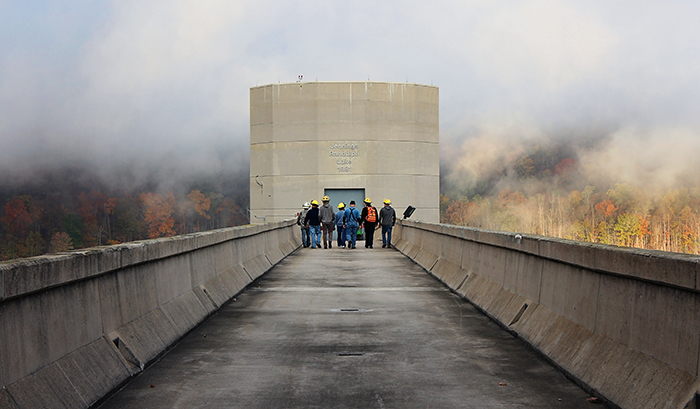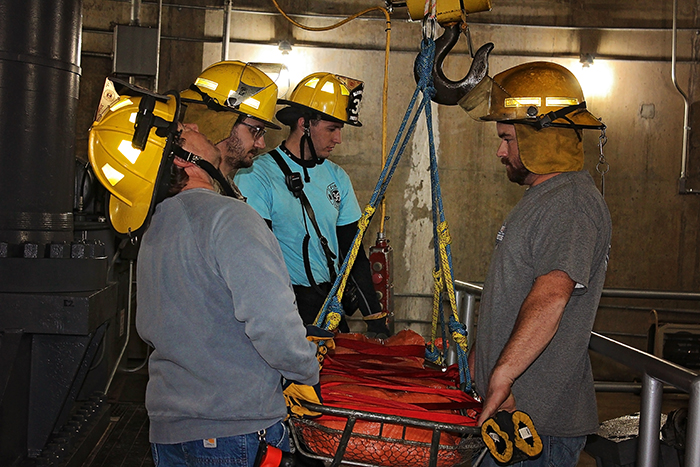The U.S. Army Corps of Engineers works alongside local, state and federal partners to ensure staff at recreation sites prioritize the well-being of the visiting public and are able to manage a wide variety of emergency situations at the drop of a hat.
Campaigns, events, rules and regulations are administered with the safety of the public at the forefront.
A few weeks ago, the tables were turned as the safety of the very employees working diligently to keep the projects running smoothly became the focus.
Corps staff and local partners participated in a joint, full-scale emergency response exercise at Jennings Randolph Lake, located between Garrett County, Maryland, and Mineral County, West Virginia, on Saturday, Oct. 28, 2017. The exercise was organized and sponsored by the Mineral County Division of Homeland Security Emergency Management (MHSEM) and the Corps. Participants included the Elk Garden, Potomac and Piedmont fire departments; Bloomington and Fountain volunteer fire departments; Elk District Ambulance and the Mineral County Special Operations Team.

First responders walk towards Jennings Randolph Lake's intake control tower on a cool fall morning in preparation for a joint, full-scale emergency response exercise held on Oct. 28, 2017. (U.S. Army photo by Cynthia Mitchell)
The group of approximately 30 emergency responders congregated shortly after sunrise to receive direction from MHSEM Director Luke McKenzie and Corps staff.
Exercise participants were presented with the following scenario: a dam operator, who experienced an electrical shock at the bottom of the JRL intake control tower, is injured and unable to move on his own. The electrical shock also resulted in a power outage that rendered the tower elevator that typically transports staff 212 feet to the second level from the bottom of the tower inoperable, along with the overhead crane, making this a specialized rescue.
“We’ve hosted safety exercises in the past with local first responders, but never anything quite like this,” said Ken Fernandez, operations project manager, JRL. “I hope what we observe and learn today can be implemented not only here to improve our safety mission, but also passed along to other Corps districts and projects.”
With marching orders in hand and the guidance of a specialized high-angle rescue team, emergency responders unloaded equipment and discussed roles in preparation for the rescue exercise to begin.
While a team of first responders descended stairs to the lower and mezzanine levels of the tower, others identified anchor points and configured an intricate system of ropes, pulleys and harnesses that several hours later would ultimately lead to the safe evaluation of the injured employee, simulated with approximately 200 pounds of sandbags in a rescue basket.

First responders located on the lower level of Jennings Randolph Lake's intake control tower prepare to hoist 200 pounds of sandbags used to simulate an injured employee nearly 212 feet towards the second level of the tower during a joint, full-scale emergency response exercise, Oct. 28, 2017. (U.S. Army photo by Cynthia Mitchell)
“Although the completion of the exercise extended past the expected timeline, the objective was completed safely and provided valuable discussion on the course of action taken to help improve the efficiency and effectiveness of this type of event in the future,” said Phil Santee, safety and occupational health specialist, Baltimore District.
Afterward, participants came together for a “Hot Wash” to discuss and evaluate each agency’s performance.
Some of the documented recommendations include requesting support from district engineering staff in order to identify and label acceptable anchor points for hoist systems; developing a 911 call sheet to assist personnel with providing essential information to first responders in a timely fashion and improving communication from the bottom of the tower.

Safety exercise organizers and participants gather for a group photo after a "Hot Wash" debrief following the dam tower safety exercise at Jennings Randolph Lake, Oct. 28, 2017. (U.S. Army photo by Cynthia MItchell)
“The exercise was a huge success and extremely valuable for continuing to improve the coordination and communication between JRL personnel and external support departments,” said Santee.
“Discussions are great, but you cannot beat hands-on experience,” said McKenzie. “This exercise will not only help first responders understand what they would have to do for a rescue at Jennings Randolph Lake, but the lessons learned from this exercise can be applied to almost any rescue scenario.”